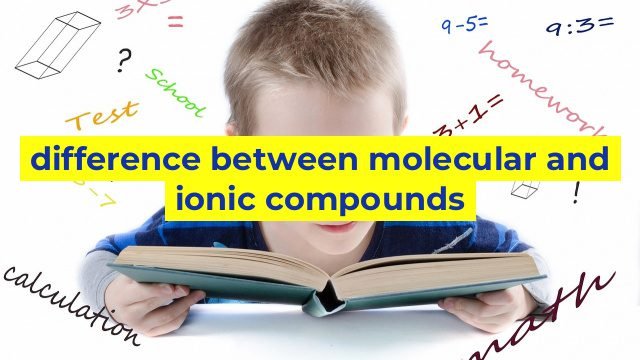The Key Differences between Molecular and Ionic Compounds
Chemical compounds can be categorized into different types based on various properties, such as molecular or ionic composition. Molecular and ionic compounds are two different types of compounds with distinct characteristics. Understanding the difference between these types of compounds is critical in the field of chemistry. Here’s a closer look at what sets molecular and ionic compounds apart.
Molecular Compounds
Molecular compounds, also known as covalent compounds, consist of two or more nonmetallic atoms that are held together by covalent bonds. In other words, they share electrons. When atoms share electrons, they form a molecule. Molecular compounds tend to have low melting and boiling points, are usually gases, and have a molecular formula that identifies the exact number of atoms of each element in the molecule. The bonding in molecular compounds is usually weaker than ionics and is determined by the electronegativity values of the atoms involved in the chemical structure. Examples of molecular compounds include water (H2O), methane (CH4), and carbon dioxide (CO2).
Ionic Compounds
On the other hand, ionic compounds consist of positively and negatively charged ions held together by electrostatic forces. Ionic compounds are usually made up of metallic and non-metallic elements. A metal atom typically loses one or more electrons to become a positively charged ion, also known as a cation, while a non-metal atom typically gains one or more electrons to become a negatively charged ion, or an anion. The resulting ions attract one another by their opposite charges to form an ionic compound. Because of the strong attraction between the positive and negative ions, ionic compounds usually have high melting and boiling points, form crystalline solids, and are often soluble in water. Examples of ionic compounds include sodium chloride (NaCl), magnesium oxide (MgO), and calcium carbonate (CaCO3).
Summary
In summary, the key difference between molecular and ionic compounds is their bonding. Molecular compounds have covalent bonds, where atoms share electrons, and usually consist of two or more non-metallic atoms. On the other hand, ionic compounds have ionic bonds, where atoms gain or lose electrons to become ions, and usually consist of a metal and a nonmetal. Understanding this fundamental difference between molecular and ionic compounds is an essential starting point for understanding their properties, behavior, and applications.
Table difference between molecular and ionic compounds
| Property | Molecular Compounds | Ionic Compounds |
|---|---|---|
| Bonding | Covalent bonding between nonmetals | Electrostatic attraction between ions (metal and nonmetal) |
| State at room temperature | Gas, liquid, or solid | Solid (usually crystalline) |
| Conductivity | Do not conduct electricity in solid or liquid state | Conduct electricity when melted or dissolved in water |
| Solubility in water | Can be soluble or insoluble | Most are soluble |
| Melting and boiling points | Low to moderate | High due to strong electrostatic forces between ions |
